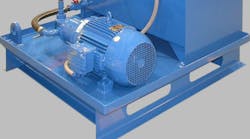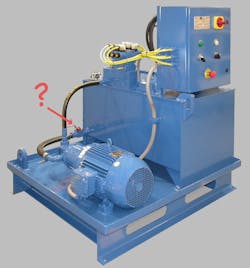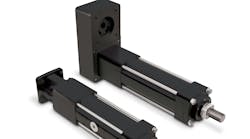In my two previous columns in H&P magazine, I’ve challenged traditional thinking about the installation of suction strainers in pump intake lines, and depth filters in the drain lines of piston pumps and motors. To recap, while the installation of both of these devices is a great idea purely from a contamination control perspective, both can have a serious, negative impact on overall reliability of the hydraulic machine.
In this column, I have a third, similar quandary for you to ponder: the installation of pump intake isolation valves. As background to this issue, at a recent hydraulic maintenance workshop I presented, I was asked for my opinion on isolation valves on pump intake lines, and whether a more expensive ball valve is mandatory, vis-à-vis the generally cheaper butterfly type.
At the root of this question is the negative effect of turbulence in the pump intake line. The argument for using a ball valve as an intake line isolation valve is that, when it’s open, the full bore of the valve is available for oil flow. So if you have a 2-in. ball valve installed in a 2-in. intake line, when the valve is open, from the oil’s point of view at least, it’s as if it wasn’t there at all.
A butterfly valve on the other hand, is not full bore. Even when fully open, the butterfly remains in the bore and presents a partial restriction which is irregular in shape. This causes turbulence, which can result in dissolved air coming out of solution in the intake line. If this happens, these air bubbles will collapse when exposed to pressure at the pump outlet. In other words, a butterfly valve may cause gaseous cavitation.
So if an intake line isolation valve is installed, which is best: ball or butterfly type? Well, like a lot of issues in hydraulics, it depends. In a perfect world I would always chose a ball valve ahead of a butterfly valve. And for intake line diameters up to 3 in. there is virtually no cost penalty involved in doing so.
But when you get into 4-, 6-, and 8-in. diameters, ball valves are very expensive in comparison to their butterfly counterparts. And they take up a lot more space—particularly in overall length. So, in a mobile application for example, not only may the cost of a large diameter ball valve be prohibitive—there may not even be enough space between the tank outlet and the pump inlet to install it!
But as you may have guessed from my introduction to this article, there is third alternative. Don’t install an intake line isolation valve at all. Intake line isolation valves are like suction strainers, in so far as many people wrongly believe they are essential. When in reality, but for a few exceptions, they are not.
Here are a few of the benefits of not installing an intake line isolation valve:
- The cost of the component is saved.
- The distance between the tank and the pump can be shortened.
- Best of all, the pump can never be started with the intake isolation valve closed!
Of course, the first question that pops into most people’s minds in response to this is: “But how can I change out the pump if there is no isolation valve on the intake line?”
There are two answers to this. The first is, if the pump has failed catastrophically and you are doing things “right,” the oil should be pumped out of the tank using a filter cart and into clean drums or other suitable container. Then the tank should be thoroughly cleaned, the pump changed out and the oil—assuming it is still serviceable—pumped back into the tank using a filter cart.
The common objections to this are: “Oh, we don’t have time for that,” or “We don’t have 10, 20, or however many clean drums sitting around!” A work-around for those who don’t want to do the job right is to seal of all penetrations into the tank headspace and connect an industrial vacuum cleaner to the tank breather penetration. Switch the vacuum cleaner on while the pump is changed-out. Then, when the debris from the previous pump failure causes the replacement pump to fail, repeat the exercise.
I know, there are exceptions. If there’s more than one pump sucking from the same tank. Or it’s just not practical to pump, say, 3,000 gal of oil out of the tank. But even in these cases, pulling a vacuum on the reservoir headspace will still work. With that said, I am willing to concede intake-line isolation valves are sometimes a necessity. In which case it’s wise to make sure they’ve got proximity switches to prevent the pump(s) from being started when the valve(s) are closed!
But despite the odd exception, my preferred approach to pump intake line isolation is: fit neither ball valve nor butterfly valve if you can get away with it. If you have to have one, use a ball valve if cost or space aren’t an issue. But if either of these things are a problem, then a butterfly valve is the only choice left.
And how bad can that be? Well in truth, I can think of many applications where butterfly valves are used as pump intake isolation valves. Large hydraulic excavators are a common example. They have multiple pumps sucking out of big tanks through large diameter intake lines and not much space between the tank and pumps. All the ingredients which can rule out my other two, more preferred options (no valve or ball valve).
I don’t think I’ve ever seen a pump taken from a large hydraulic excavator that didn’t have at least some cavitation erosion damage. In this severe-duty application the damage can be regarded as fair wear and tear. Could this cavitation damage be attributed to turbulence caused by the presence of a butterfly valve? Sure it could. But a lot of other things could be responsible for it too. And the only way to know for sure would be to compare two pumps operating under exactly the same conditions—one with a butterfly valve installed and one without. If you know of a hydraulic machine OEM who has this type of empirical data, I would love to hear about it.


